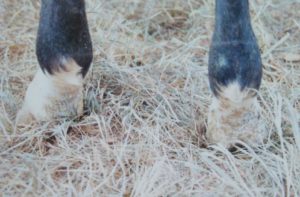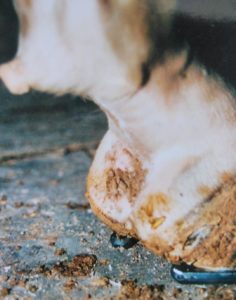Did Justify Have Scratches?
Last Saturday (5 May 2018) Justify, trained by Bob Baffert, won the 144th Kentucky Derby. He is the first three-year-old (not having been raced as a two-year-old) to win the Kentucky Derby since Apollo in 1882. Most horses that run in the Derby are two-year-olds. Justify ran the 1 ¼ mile race in 2 minutes and 4.2 seconds. A record amount of rain and a muddy track made for very wet and sloppy conditions.
Much has been made of a post-race video in which trainer Baffert, led the horse around and Justify took a few bad steps. In particular, he seemingly showed signs of lameness in his left hind foot. Animal rights fanatics have quickly rallied and blamed horse trainers and jockeys for mistreatment of animals. Some have even gone so far as to call for bans on racing horses altogether.
Before people begin to criticize trainers, jockeys and the horse racing sport as a whole, it is important to gather more information. Justify indeed looks stiff in the post-race video, but he just accomplished a great feat! Does anyone have sympathy for the pro basketball player who hobbles off the court after giving his or her all in a championship play-off game? Few people rally and call for the end of championship basketball games when they see an athlete coping with lactic acid build-up and sore muscles! Good racehorses generally have an aptitude for racing. Horses can be extremely competitive and in many cases, the jockey must hold the horse back to prevent the horse from giving too much too fast. This type of horse will inevitably have some short-term inflammation in the muscles, tendons and joints just as any professional athlete would.
At first it was thought that Justify had a condition known as “scratches.” Later it was determined that the horse did not have scratches, but instead a bruised foot. Veterinarians are now treating the bruise in hopes of preparing Justify for the Preakness on May 19. A minor skin rash over the pastern area was mistaken for scratches on the horse.
What is Scratches?
People that have no experience with horses might have been confused by the term, “scratches.” Scratches does not necessarily refer to a tear in the skin because of a sharp object. “Scratches” refers to a dermatitis where there can be irritating skin chapping and crusty scab formation. It has also been referred to as grease heel and mud fever. It may be compared to eczema in humans. There may also be inflammation of the sebaceous glands (glands in the skin that secrete lubricating oil into hair follicles) in this pastern area. The skin over the pastern region is especially sensitive and the condition is made much worse by wet weather. The condition is fairly common among horses that live in wet climates. Some horses seem to be more predisposed to it than others due to genetic inheritance of sensitive skin. These thin-skinned horses (often with light coats) can develop a rash that later turns into scratches. Thankfully, the rash that Justify had after the race has been treated so that it won’t turn into something worse.

A severe case of scratches was caused by heavy dew on the grass in this case. This dermatitis should be treated with topical ointments.
Scratches can also be caused by constant exposure to mud. It is difficult to treat the condition when a horse lives in an area where it rains a lot. More horses are reported to have scratches in the springtime when it is raining frequently. Heavy dew in grassy pastures can also contribute to the cause. Scratches can also be caused by filthy stabling conditions. The condition can be aggravated by deep track conditions and stretching of the skin.
In show horses, owners sometimes clip the hair around the fetlock sometimes referred to as the “feather.” The feather has a protective function of diverting moisture away from the sensitive pastern area by having moisture from rain or sweat drip down the fetlock onto the feather and then the ground. If the feather is clipped or the horse simply does not grow a prominent feather, the horse may be more at risk for scratches. Conversely, horses with very thick feathers (such as draft horses) can get moisture trapped inside the thick (sometimes filthy) hair and cause skin irritation as well.
Scratches is usually treated with a topical ointment of some kind. Sulfa urea cream and nitrafurazone are popular topical applications. Desitin, Vaseline, Corona and Neosporin have all been recommended as suitable applicants for horses afflicted with scratches. Of course, the best treatment is to keep the horse in dry conditions if possible. A horse may be getting the best care, but when it rains a lot, the horse may have a flare-up. In minor cases, scratches can be managed and it won’t interfere with the horse’s occupation.
Related Posts
-
National Farriers Week is a dedicated time for horse owners ...Jul 12, 2018 / 0 comments
-
This time of year it is wise to stay warm and safe when ridi...Jan 30, 2020 / 0 comments
-
Happy New Year! The New Year brings with it a determination ...Jan 30, 2015 / 0 comments
Blog Categories
- Anatomy
- Best Business Practices
- Conformation
- Current Events
- Customer Service
- Draft Horse Shoeing
- Equine Soundness
- Essential Anatomy Kit
- Farrier Careers
- Farrier training
- Foal soundness
- Horse Care
- Horse Foot Care
- Horse Owner Tips
- Horsemanship
- Horseshoeing
- Horseshoeing History
- Iron and Forge Work
- Student Spotlight
- Uncategorized
- Veterinary Care
Blog Archives
Contact Us
Butler Professional Horseshoeing School
495 Table Road
Crawford, NE 69339
(800) 728-3826
jacob@dougbutler.com
Subscribe to Our Blog
Get Our Free e-Book!
If you think you want to become a farrier (or know someone who does), this book can help you make that decision. Horse owners will learn the importance of choosing a qualified farrier and how to select the “right” one.
[ Get the e-Book Now! ]
- Follow:

